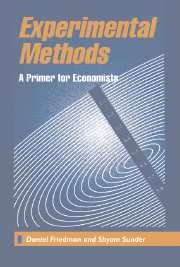Book contents
- Frontmatter
- Contents
- List of figures and tables
- Preface
- Acknowledgments
- EXPERIMENTAL METHODS
- 1 Introduction
- 2 Principles of economics experiments
- 3 Experimental design
- 4 Human Subjects
- 5 Laboratory facilities
- 6 Conducting an experiment
- 7 Data analysis
- 8 Reporting your results
- 9 The emergence of experimental economics
- Appendixes: Supplemental materials
- I Readings in experimental economics
- II Instructions and procedures
- III Forms
- IV Econometrica guidelines
- V List of experimental economics laboratories
- Glossary
- References
- Index
II - Instructions and procedures
Published online by Cambridge University Press: 05 June 2012
- Frontmatter
- Contents
- List of figures and tables
- Preface
- Acknowledgments
- EXPERIMENTAL METHODS
- 1 Introduction
- 2 Principles of economics experiments
- 3 Experimental design
- 4 Human Subjects
- 5 Laboratory facilities
- 6 Conducting an experiment
- 7 Data analysis
- 8 Reporting your results
- 9 The emergence of experimental economics
- Appendixes: Supplemental materials
- I Readings in experimental economics
- II Instructions and procedures
- III Forms
- IV Econometrica guidelines
- V List of experimental economics laboratories
- Glossary
- References
- Index
Summary
This appendix collects instructions and procedures for several different kinds of experiments, including oral double auction and posted offer markets, committee decisions, bargaining, computerized asset markets, overlapping generations economies, and normal form games. You may want to use simplified versions for classroom demonstrations or may want to elaborate the procedures in some respects for your own research experiments. If you can't find instructions or procedures here for the kind of experiment you wish to conduct, do not hesitate to request them from the author of a relevant article. Most experimentalists will be happy to comply.
Instructions for experiments
Instructions
General
This is an experiment in the economics of market decision making. Various research foundations have provided funds for the conduct of this research. The instructions are simple, and if you follow them carefully and make good decisions you might earn a considerable amount of money which will be paid to you in cash after the experiment.
In this experiment we are going to stimulate a market in which some of you will be buyers and some of you will be sellers in a sequence of market days or trading periods. Two kinds of sheets will now be distributed—information for buyers and information for sellers. The sheets are identified and numbered. The number is only for data-collecting purposes. If you have received sellers' information, you will function only as a seller in this market. Similarly, if you have received buyers' information, you will function only as a buyer in this market.
Information
- Type
- Chapter
- Information
- Experimental MethodsA Primer for Economists, pp. 174 - 200Publisher: Cambridge University PressPrint publication year: 1994
